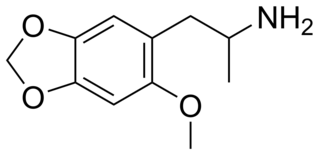
Empathogens or entactogens are a class of psychoactive drugs that produce experiences of emotional communion, oneness, relatedness, emotional openness—that is, empathy or sympathy—as particularly observed and reported for experiences with 3,4-methylenedioxymethamphetamine (MDMA). This class of drug is distinguished from the classes of hallucinogen or psychedelic, and amphetamine or stimulant. Major members of this class include MDMA, MDA, MDEA, MDOH, MBDB, 6-APB, methylone, mephedrone, αMT, and αET, MDAI among others. Most entactogens are phenethylamines and amphetamines, although several, such as αMT and αET, are tryptamines. When referring to MDMA and its counterparts, the term MDxx is often used. Entactogens are sometimes incorrectly referred to as hallucinogens or stimulants, although many entactogens such as ecstasy exhibit psychedelic or stimulant properties as well.

3,4-Methylenedioxyamphetamine is an empathogen-entactogen, psychostimulant, and psychedelic drug of the amphetamine family that is encountered mainly as a recreational drug. In terms of pharmacology, MDA acts most importantly as a serotonin–norepinephrine–dopamine releasing agent (SNDRA). In most countries, the drug is a controlled substance and its possession and sale are illegal.

5-(2-Aminopropyl)-2,3-dihydro-1H-indene (5-APDI), also known as indanylaminopropane (IAP), IAP (psychedelic), 2-API(2-aminopropylindane), indanametamine, and, incorrectly, as indanylamphetamine, is an entactogen and psychedelic drug of the amphetamine family. It has been sold by online vendors through the Internet and has been encountered as a designer drug since 2003, but its popularity and availability has diminished in recent years.

Substituted methylenedioxy- phenethylamines (MDxx) are a large chemical class of derivatives of the phenethylamines, which includes many psychoactive drugs that act as entactogens, psychedelics, and/or stimulants, as well as entheogens. These agents are used as research chemicals, designer drugs and as recreational substances.

1,3-Benzodioxolylbutanamine is an entactogenic drug of the phenethylamine chemical class. It is the α-ethyl analog of MDPEA and MDA and the methylenedioxy analogue of α-ethylphenethylamine.

MMDA-2 (2-methoxy-4,5-methylenedioxyamphetamine) is a psychedelic drug of the amphetamine class. It is closely related to MMDA and MDA.

N-Methyl-2-methoxy-4,5-methylenedioxyamphetamine is a psychedelic drug of the amphetamine class. It is the N-methylated derivative of MMDA-2, and it is also an analog of MDMA and 6-methyl-MDA.

3,4-Methylenedioxy-N,N-dimethylamphetamine (MDDM) is a lesser-known research chemical. It is also the N,N-dimethyl analog of 3,4-methylenedioxyamphetamine (MDA). MDDM was first synthesized by Alexander Shulgin. In his book PiHKAL , the dosage is unspecified and the duration unknown. MDDM produces only mild effects that are not well characterized in PiHKAL. Very little data exists about the pharmacological properties, metabolism, and toxicity of MDDM. This compound is however occasionally encountered as an impurity in 3,4-methylenedioxy-N-methylamphetamine (MDMA) which has been synthesized by methylation of MDA using methylating reagents such as methyl iodide. An excess of reagent or a reaction temperature that is too high results in some double methylation of the amine nitrogen, yielding MDDM as well as MDMA. The presence of MDDM as an impurity can thus reveal which synthetic route was used to manufacture seized samples of MDMA.

Indane or indan is an organic compound with the formula C6H4(CH2)3. It is a colorless liquid hydrocarbon. It is a petrochemical, a bicyclic compound. It occurs at the level of about 0.1% in coal tar. It is usually produced by hydrogenation of indene.

5-Methyl-3,4-methylenedioxyamphetamine (5-Methyl-MDA) is an entactogen and psychedelic designer drug of the amphetamine class. It is a ring-methylated homologue of MDA and a structural isomer of MDMA.

5-(2-Aminopropyl)-2,3-dihydrobenzofuran is a putative entactogen drug of the phenethylamine and amphetamine classes. It is an analogue of MDA where the heterocyclic 3-position oxygen from the 3,4-methylenedioxy ring has been replaced by a methylene bridge. 6-APDB is an analogue of 5-APDB where the 4-position oxygen has been replaced by a methylene bridge instead. 5-APDB was developed by a team led by David E. Nichols at Purdue University as part of their research into non-neurotoxic analogues of MDMA.

MDAI (5,6-methylenedioxy-2-aminoindane) is a drug developed in the 1990s by a team led by David E. Nichols at Purdue University. It acts as a non-neurotoxic and highly selective serotonin releasing agent (SSRA) in vitro and produces entactogen effects in humans.

3-Methoxy-4-methylamphetamine (MMA) is an entactogen and psychedelic drug of the phenethylamine and amphetamine classes. It was first synthesized in 1970 and was encountered as a street drug in Italy in the same decade. MMA was largely forgotten until being reassayed by David E. Nichols as a non-neurotoxic MDMA analogue in 1991, and has subsequently been sold as a designer drug on the internet since the late 2000s (decade).
A serotonin releasing agent (SRA) is a type of drug that induces the release of serotonin into the neuronal synaptic cleft. A selective serotonin releasing agent (SSRA) is an SRA with less significant or no efficacy in producing neurotransmitter efflux at other types of monoamine neurons.

α-Methyldopamine (α-Me-DA), also known as 3,4-dihydroxyamphetamine, is a research chemical of the catecholamine and amphetamine chemical classes. Its bis-glutathionyl metabolite is slightly neurotoxic when directly injected into the brain's ventricles.

2-Methyl-3,4-methylenedioxyamphetamine (2-methyl-MDA) is an entactogen and psychedelic drug of the amphetamine class. It acts as a selective serotonin releasing agent (SSRA), with IC50 values of 93nM, 12,000nM, and 1,937nM for serotonin, dopamine, and norepinephrine efflux. 2-Methyl-MDA is more potent than MDA and 5-methyl-MDA. However, it is slightly more selective for serotonin over dopamine and norepinephrine release in comparison to 5-methyl-MDA.

6-(2-Aminopropyl)-2,3-dihydrobenzofuran is a stimulant and entactogen drug of the phenethylamine and amphetamine classes. It is an analogue of MDA where the heterocyclic 4-position oxygen from the 3,4-methylenedioxy ring has been replaced with a methylene bridge. 5-APDB (3-Desoxy-MDA) is an analogue of 6-APDB where the 3-position oxygen has been replaced with a methylene instead. 6-APDB, along with 5-APDB, was first synthesized by David E. Nichols in the early 1990s while investigating non-neurotoxic MDMA analogues.

4-Chlorophenylisobutylamine, also known as 4-chloro-α-ethylphenethylamine, is an entactogen and stimulant drug of the phenethylamine class. It is an analogue of para-chloroamphetamine (PCA) where the alpha position methyl has been replaced with an ethyl group.

Difluoromethylenedioxyamphetamine (DiFMDA) is a substituted derivative of 3,4-methylenedioxyamphetamine (MDA), which was developed by Daniel Trachsel and coworkers, along with the corresponding fluorinated derivatives of MDMA, MDEA, BDB and MBDB, with the aim of finding a non-neurotoxic drug able to be used as a less harmful substitute for entactogenic drugs such as MDMA. Since a major route of the normal metabolism of these compounds is scission of the methylenedioxy ring, producing neurotoxic metabolites such as alpha-methyldopamine, it was hoped that the difluoromethylenedioxy bioisostere would show increased metabolic stability and less toxicity.

3,4-Ethylidenedioxyamphetamine (EIDA) is a substituted derivative of 3,4-methylenedioxyamphetamine (MDA), which was developed by David Nichols and coworkers, in the course of research to determine the bulk tolerance around the benzodioxole portion of the MDA molecule. EIDA was found to produce similar effects to MDA in animals but with less than half the potency, while the isopropylidenedioxy derivative did not substitute for MDA and instead had sedative and convulsant effects. This shows limited bulk tolerance at this position and makes it likely the activity of EIDA will reside primarily in one enantiomer, although only the racemic mix has been studied as yet.



















